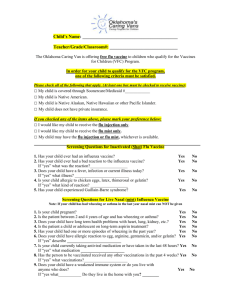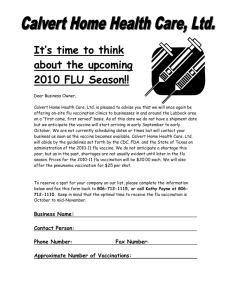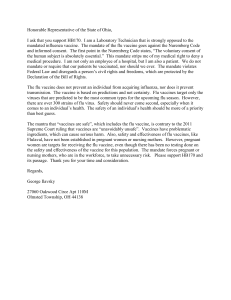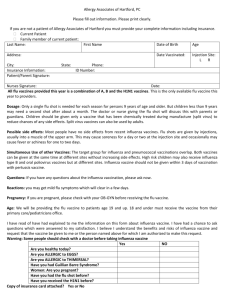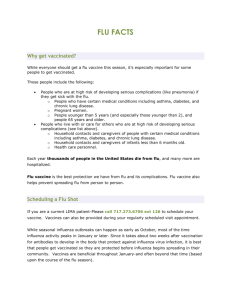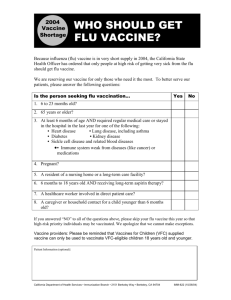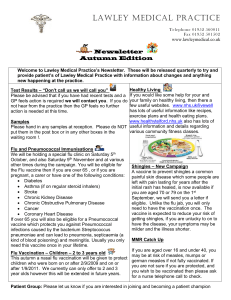To Mandate or Not To Mandate: Should There Be Mandatory... Vaccinations for Health Care Workers? Introduction
advertisement
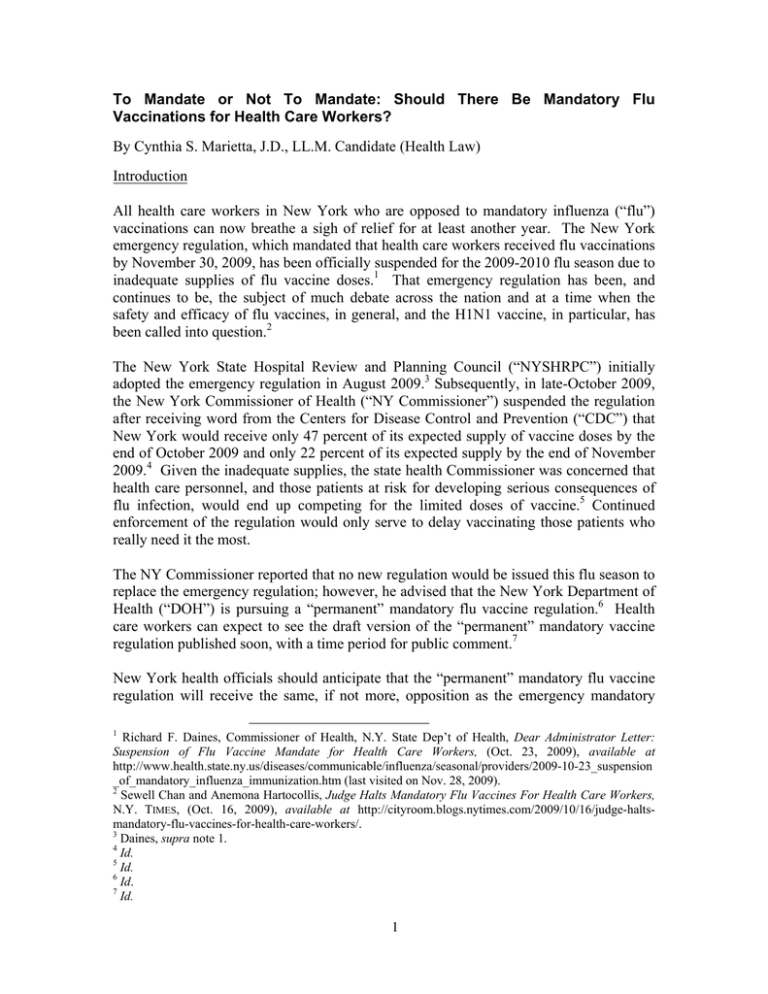
To Mandate or Not To Mandate: Should There Be Mandatory Flu Vaccinations for Health Care Workers? By Cynthia S. Marietta, J.D., LL.M. Candidate (Health Law) Introduction All health care workers in New York who are opposed to mandatory influenza (“flu”) vaccinations can now breathe a sigh of relief for at least another year. The New York emergency regulation, which mandated that health care workers received flu vaccinations by November 30, 2009, has been officially suspended for the 2009-2010 flu season due to inadequate supplies of flu vaccine doses.1 That emergency regulation has been, and continues to be, the subject of much debate across the nation and at a time when the safety and efficacy of flu vaccines, in general, and the H1N1 vaccine, in particular, has been called into question.2 The New York State Hospital Review and Planning Council (“NYSHRPC”) initially adopted the emergency regulation in August 2009.3 Subsequently, in late-October 2009, the New York Commissioner of Health (“NY Commissioner”) suspended the regulation after receiving word from the Centers for Disease Control and Prevention (“CDC”) that New York would receive only 47 percent of its expected supply of vaccine doses by the end of October 2009 and only 22 percent of its expected supply by the end of November 2009.4 Given the inadequate supplies, the state health Commissioner was concerned that health care personnel, and those patients at risk for developing serious consequences of flu infection, would end up competing for the limited doses of vaccine.5 Continued enforcement of the regulation would only serve to delay vaccinating those patients who really need it the most. The NY Commissioner reported that no new regulation would be issued this flu season to replace the emergency regulation; however, he advised that the New York Department of Health (“DOH”) is pursuing a “permanent” mandatory flu vaccine regulation.6 Health care workers can expect to see the draft version of the “permanent” mandatory vaccine regulation published soon, with a time period for public comment.7 New York health officials should anticipate that the “permanent” mandatory flu vaccine regulation will receive the same, if not more, opposition as the emergency mandatory 1 Richard F. Daines, Commissioner of Health, N.Y. State Dep’t of Health, Dear Administrator Letter: Suspension of Flu Vaccine Mandate for Health Care Workers, (Oct. 23, 2009), available at http://www.health.state.ny.us/diseases/communicable/influenza/seasonal/providers/2009-10-23_suspension _of_mandatory_influenza_immunization.htm (last visited on Nov. 28, 2009). 2 Sewell Chan and Anemona Hartocollis, Judge Halts Mandatory Flu Vaccines For Health Care Workers, N.Y. TIMES, (Oct. 16, 2009), available at http://cityroom.blogs.nytimes.com/2009/10/16/judge-haltsmandatory-flu-vaccines-for-health-care-workers/. 3 Daines, supra note 1. 4 Id. 5 Id. 6 Id. 7 Id. 1 regulation. In the several weeks after the emergency regulation was issued, separate groups of New York nurses and union members had filed lawsuits against the DOH, seeking injunctive relief against enforcement of the mandate.8 A judge consolidated the three lawsuits and issued a temporary restraining order (“TRO”) against the DOH, prohibiting it from enforcing the regulation.9 The TRO matter was set for hearing to decide whether the DOH would be permanently enjoined from enforcing such mandate.10 However, the TRO became a moot point when the NY Commissioner announced suspension of the emergency regulation. Although the TRO was short-lived, it was deemed a significant win for health care workers. Conceivably, the language in the soon-to-be released draft “permanent” mandatory vaccine regulation will be similar to the language in the suspended emergency regulation. And more than likely, nursing organizations and union members will rally to fight the “permanent” regulation in court, just as they fought the emergency regulation. No doubt, health care officials, nursing groups and interested stake holders in other states will watch the battle with keen interest because the result may have a ripple effect across the nation. Perhaps now is the time, in the wake of the suspension and before a “permanent” mandatory vaccination regulation is finalized, for health care officials and health care workers alike to objectively consider the benefits and disadvantages of mandatory flu vaccinations for health care workers, and collectively seek to devise an effective flu vaccination plan that will reconcile and satisfy all parties’ objectives and interests. The Suspended Emergency Regulation – What Does it Say? More than likely, the language contained in the emergency regulation will serve as the building blocks for the “permanent” regulation. The emergency regulation states, in part: Every health care facility in this state shall notify all personnel of the requirement and require that personnel be immunized against the influenza virus(es) as a precondition of employment and on an annual basis.11 “Health care facilities” are defined as including general hospitals, diagnostic and treatment centers, home health agencies, long-term health care programs, AIDS home care programs, and hospices.12 “Personnel,” made the subject of this mandate, includes: …[A]ll persons employed or affiliated with a health care facility, whether paid or unpaid, including but not limited to employees, members of the 8 Anemona Hartocollis and Sewell Chan, Albany Judge Blocks Vaccination Rule, N.Y. TIMES, Oct. 16, 2009, available at http://www.nytimes.com/2009/10/17/nyregion/17vaccine.html. 9 Id. 10 Id. 11 10 NY ADC § 66-3.2 (2009). 12 10 NY ADC § 66-3.1(c) (2009). 2 medical staff, contract staff, students, and volunteers, who either have direct contact with patients or whose activities are such that if they were infected with influenza, they could potentially expose patients, or others who have direct contact with patients, to influenza. . . .13 Each health care facility must provide or arrange for influenza vaccinations at no cost to its personnel, and personnel may choose to receive the vaccination from another source as long as he or she provides documentation for having received the vaccination.14 The only exception to this mandate is if the vaccine is medically contraindicated for the health care worker. Then, the facility must then determine what precautionary measures the exempt health care worker should use to reduce the risk of transmitting influenza to patients.15 The deadline for personnel to receive their influenza vaccines is by November 30th of each year.16 Each health care facility must maintain records, documenting the annual vaccinations of personnel in their personnel files, and proof of vaccination received offsite.17 Contrary to what some media venues have reported, the emergency regulation does not explicitly state that health care workers will lose their jobs if they do not comply with the mandate. Hospitals and unions, however, have inferred that the regulation means health care workers who do not comply may be fired.18 The individual facilities that are subject to this regulation are faced with the challenge of implementing and complying with this regulation and have more or less told employees that noncompliance may result in discipline and even termination.19 The Rationale Behind Issuing the Emergency Regulation – What Was the Purpose? The United States Department of Health and Human Services (“HHS”) claims that vaccination of health care workers is the cornerstone to flu prevention.20 Health care personnel should be vaccinated for two reasons: (1) to reduce the occupational risk of flu infection, and (2), to prevent the transmission of the flu virus to patients at risk of secondary complications and death.21 Despite these reasons, statistics show that health care workers have a tendency to avoid flu vaccinations. Researchers report that, between 1985 and 2002, the flu vaccination rates for healthcare workers on a worldwide basis 13 10 NY ADC § 66-3.1(b) (2009). 14 10 NY ADC § 66-3.3 (2009). 15 10 NY ADC § 66-3.6 (2009). 16 10 NY ADC § 3.3 (2009). 17 10 NY ADC § 66-3.5 (2009). 18 Hartocollis, supra note 8. 19 Id. 20 U.S. Dep’t of Health & Human Servs., Health Care Personnel Initiative to Improve Influenza Vaccination and Toolkit, available at http://www.hhs.gov/ophs/programs/initiatives/vacctoolkit/index.html. 21 Id. 3 ranged between 2.1 percent to 82 percent.22 In 2007, only 41.8 percent of healthcare workers were vaccinated during the 2007-2008 flu season.23 According to the NY Commissioner, the primary purpose for the New York emergency mandate was to protect hospital patients whose immune systems are often weakened by their illnesses.24 The Commissioner publicly acknowledged that patient safety was the key consideration in driving the mandated flu vaccine regulation, believing that “[p]atients in . . . health care settings have the right to expect that they will not be infected by their health care worker with a preventable disease that could be fatal.”25 Shortly after the mandate was issued, the Commissioner explained that, “[g]iven the outstanding efficacy and safety record of approved influenza vaccines, [health care workers’] overriding concern then . . . should be the interests of [their] patients, not [their] own sensibilities about mandates.”26 The welfare of patients is best served by the high rates of staff immunity that can be achieved only with mandatory influenza vaccination. Medical studies have convincingly demonstrated that high levels of staff immunity provide protection for those patients who cannot be or have not been effectively vaccinated themselves, while also allowing institutions to remain more fully staffed.27 The DOH claims its officials had clear legal authority to require the vaccinations, citing a 1990 New York court ruling, which rejected a challenge to regulations requiring mandatory rubella vaccinations and annual tuberculosis testing for health care workers. 28 The court ruled: “[H]ospitals … exist for the benefit of patients. They exist to cure the sick. The Legislature of this State has charged the Commissioner of Health with the responsibility of making hospitals safe places to get well. These regulations are tailored to accomplish that end.”29 Mandatory vaccines are not a novel concept in New York. Like other states, New York requires mandatory vaccinations for children, including the polio vaccine, the measles, mumps, and rubella (“MMR”) shots, the diphtheria-pertussis-tetanus (“DPT”) shots, Hepatitis B shots, and varicella (chicken pox) shots.30 22 Id. 23 Centers for Disease Control and Prevention, CDC Features: It’s Not Too late to Vaccinate, available at http://www.cdc.gov/Features/FluPrevention (last updated Dec. 8, 2008). 24 Hartocollis, supra note 8. 25 Daines, supra note 1. 26 Chan, supra note 2. 27 Id. 28 Id. 29 Id. 30 See N.Y. State Dep’t of Health, Bureau of Immunization, available at http://www.health. state.ny.us/publications/2370.pdf; see also States News Service, Mandatory Vaccinations: What the State Law Requires, N.Y. TIMES, (Jan. 20, 1991), available at http://www.nytimes.com/1991/01/20/nyregion/ mandatory-vaccinations-what-the-state-law-requires.html. 4 What Are The Objections to Mandated Flu Vaccines? Unions and professional health care organizations have reportedly objected to mandatory flu vaccinations because the mandate is conditioned on maintaining employment. Individual health care workers, however, tend to object for a number of other reasons. The most prevalent objection stems from the concern about the safety of flu vaccines, in general, and the H1N1 vaccine, in particular.31 Many believe that, in the rush to roll-out the H1N1 vaccine to the public nationwide, the United States Food and Drug Administration (“FDA”) failed to conduct the proper clinical trials and adequate testing for safety and efficacy of the H1N1 vaccine.32 The conscientious objectors,33 those who oppose mandatory vaccinations based on personal beliefs, or religious or moral reasons, cite various reasons. For instance, some healthcare workers maintain staunch opinions that a mandate to get vaccinated violates their constitutional right to choose their own medical treatment.34 Others maintain firm beliefs that their immune systems are intact and they do not need the vaccine,35 while other workers exercise their religious convictions against vaccinations, believing in the power of faith healing or other theological doctrines.36 The workers who have medical conditions in which a vaccine would be medically contraindicated are the only individuals exempt from the regulation.37 This would include those who are allergic to eggs – the medium used to grow vaccine strains.38 The concern about the safety and efficacy of the H1N1 vaccine may possibly fade soon. Just recently, Margaret A. Hamburg, M.D., the Commissioner of FDA, issued a letter addressed to U.S. physicians, thanking them for their efforts during the 2009 H1N1 influenza outbreak.39 The gist of the letter focuses on the process used in making the H1N1 vaccine and the status of the clinical trials conducted to test the safety and efficacy of the vaccines.40 Specifically, the letter outlines why the FDA has confidence in the H1N1 vaccines now available for use.41 It details the steps involved in manufacturing the H1N1 vaccine and reports these steps are the same as used for manufacturing the seasonal flu vaccine. The steps include: (1) modifying the virus into a version suitable to be used as the ”seed” to develop vaccines, (2) growing the vaccine strain in specially 31 Jennifer Steinhauer, Swine Flu Shots Revive a Debate About Vaccines, N.Y. TIMES, Oct. 15, 2009, available at http://www.nytimes.com/2009/10/16/health/16vaccine.html. 32 Physorg.com, Lawsuit Seeks to Halt U.S. Swine Flu Vaccination Campaign, Oct. 15, 2009, available at www.physorg.com/news174847447.html. 33 Nancy Berlinger, Conscience Clauses, Health Care Providers, and Parents, THE HASTINGS CENTER, available at http://www.thehastingscenter.org/Publications/BriefingBook/Detail.aspx?id=2266. 34 Anemona Hartocollis, Mandatory Flu Vaccination for N.Y. Health Workers Is Criticized, N.Y. TIMES, Oct. 14, 2009, available at http://www.nytimes.com/2009/10/14/health/policy/14vaccine.html. 35 Donald G. McNeil, Jr., New York Health Care Workers Resist Flu Vaccine Rule, N.Y. TIMES, Sept. 21, 2009, available at http://www.nytimes.com/2009/09/21/nyregion/21vaccine.html. 36 Berlinger, supra note 33. 37 See 10 NY ADC § 66-3.6 (2009). 38 U.S. Food and Drug Admin., Letter from the Commissioner to Nation’s Doctor on H1N1 Vaccine, Nov. 10, 2009, available at http://www.fda.gov/NewsEvents/PublicHealthFocus/ucm189691.htm. 39 Id. 40 Id. 41 Id. 5 produced eggs, (3) measuring the amount of vaccine antigen being produced and then developing the reagents needed to assure the proper amount of antigen goes into each dose of vaccine, (4) initiating clinical trials to determine the proper dose and number of doses needed to induce an optimal immune response in adults and children, (5) evaluating each lot of vaccines to ensure sterility and potency before releasing it for use, and (6) continuing to monitor the vaccines for any unexpected, rare or serious adverse effects.42 Perhaps the FDA Commissioner should have addressed this letter to all health care workers, and not just physicians, to help quell fears about the status of the safety of H1N1 vaccine. Conclusion There seems to be no right or wrong answer to the question of whether health care workers should be subjected to mandatory flu vaccinations. Proponents and opponents alike have valid arguments to support their respective positions. However, now is a good time, when the heat is off to enforce mandatory vaccinations and the “permanent” regulation is still in its draft phase, for both sides to come together and reconcile this issue before the onset of next flu season. A satisfactory resolution would result in a “win-win” situation for healthcare workers and patients. Health Law Perspectives (December 2009) Health Law & Policy Institute University of Houston Law Center http://www.law.uh.edu/healthlaw/perspectives/homepage.asp 42 Id. 6
